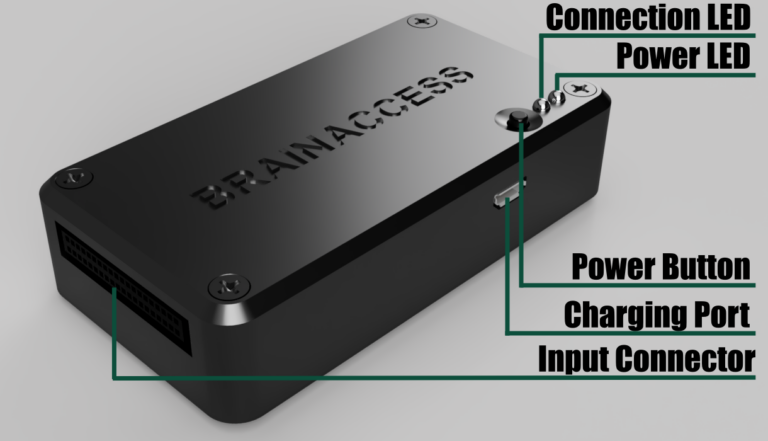BrainAccess MIDI
BrainAccess MIDI is a 16-channel electroencephalograph with a common reference channel. It is more powerful than MINI with extra EEG channels and longer battery life.
Overview
USB Bluetooth adapter
The device comes with a USB Bluetooth 4.2 adapter, which is used to communicate and stream data to the computer from BrainAccess MIDI. If preferred, a different Bluetooth adapter such as an integrated Bluetooth adapter in a laptop may be used instead.
Power switch
Press and hold a push button for a couple of seconds to turn the device on/off. The power LED will be lit when powered on.
Charging port
Our EEG hardware device's battery can be charged via a micro-USB port using standard 5V chargers such as mobile phone chargers with a micro-USB plug. The charger should be capable of providing at least 800 mA of current. Do not use the device when charging with chargers powered from grid electricity due to safety reasons and potentially 50/60 Hz noise affecting the signals. The device can be used when charging from a power bank though.
Power LED
It is a red-colored LED that indicates when the device is powered on. If the power LED starts blinking, it indicates that the battery level is below 10% and needs charging soon.
Connection LED
It is a blue-colored LED that indicates when a Bluetooth connection is established between a computer and the device.
EEG inputs
These inputs should be connected to electrodes that measure EEG activity with respect to the reference electrode.
Input connector-converter
An input connector-converter has input connections for all the cables coming from each electrode on one end and a single socket connection to the MIDI on the other end. This allows, for example, disconnecting MIDI quickly from an EEG cap and connecting to another EEG cap with a different setup.
Reference input
An input that should be connected to a common reference electrode. In BrainAccess Kit setups it is typically an electrode placed at Fp1 location. The connection is denoted as 'R' on the device.
Bias input
An input that should be connected to a bias electrode. In BrainAccess Kit setups it is typically an electrode placed at Fp2 location. The connection is denoted as 'B' on the device. It is a driven bias that reduces the common mode noise such as noise coming from the grid electricity. The bias signal is derived from any of the EEG inputs which can be chosen in software. They are denoted as 'bias feedback channels' in software. Use only channels/electrodes that have good-quality signals for bias feedback.
Digital input
The device has an additional digital input that is sampled at the same rate as EEG signals and is treated as an additional input channel in software. It can be used for connecting external sensors or for synchronizing multiple BrainAccess MIDI devices. The digital input is internally pulled high and is driven low when input contacts are closed. An external switch or open-collector/open-drain circuits can be used to close the digital input contacts and drive the digital signal low.
Accelerometer
The device has an integrated 3-axis accelerometer. It can be used for example to record any body/head movements when it is attached to the EEG hardware. The accelerometer data comes as 3 additional input channels in the software.
Velcro tape attachment
A velcro tape can be found at the bottom of the device that can be used to attach it to the BrainAccess CAP.
Specifications
Specifications of BrainAccess MIDI electroencephalograph.
Connectivity | |
Type | Bluetooth 4.2 |
Range | up to 10m (using the provided Bluetooth adapter) |
EEG Input Channels | |
Number of channels | 16 with a common reference channel |
Sampling frequency | 250 Hz |
Input resolution | 24 bits |
Analog gain values | 1, 2, 4, 6, 12, 24 |
Input voltage range | 4500 mV / gain value (w.r.t. reference channel) |
Input connector | Ultra-mini RF coaxial connector |
Digital Input Channel | |
Type | internally pulled-up, driven low by closing the input contacts |
Sampling frequency | 250Hz |
Connector | JST right-angle, 2 mm pitch, cable with a plug also provided |
Accelerometer | |
Number of axis | 3 |
Sampling frequency | 50Hz (resampled to 250Hz in software) |
Range | +/-2g |
Resolution | 10 bits |
Battery | |
Type | Li-Po |
Capacity | 2200 mAh |
Operating time | up to 9 hours (continuous streaming, all channels turned on) |
Charging time | 3 hours |
Charger input | 5V 800 mA min (charger not included) |
Charger connector | micro-usb |
Mechanical | |
Mass | 85g |
Dimensions | 92x50x23 mm |

